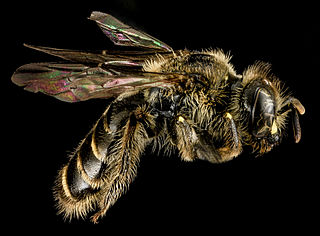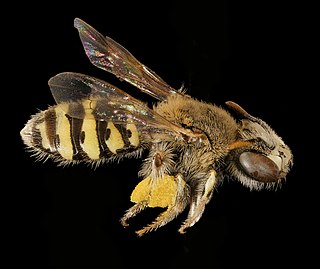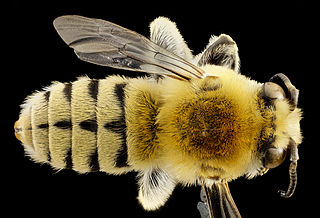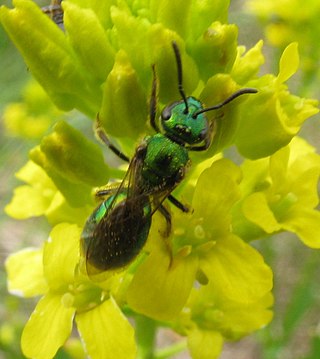Related Research Articles

Hylaeus is a large and diverse cosmopolitan genus within the bee family Colletidae. This genus is also known as the yellow-faced bees or masked bees. This genus is the only truly globally distributed colletid, occurring on all continents except Antarctica.

Macrotera is a genus of bees native to North America, particularly diverse in the desert regions of the United States and Mexico. According to Wilson and Carril, there are "around 30" species of Macrotera. Macrotera are small to medium sized and often black or reddish in coloration. The genus was treated by P.H. Timberlake who, in addition to T.D.A. Cockerell, described most of the known species. Macrotera used to be considered part of the genus Perdita but was split apart by C.D. Michener in 2000. Most species are extreme specialists (oligoleges) with respect to pollen and will only collect pollen from a few closely related species or genera of plants, particularly the plant genus Sphaeralcea and various Cactaceae.

Calliopsis is a genus of panurgine bees in the family Andrenidae. There are over 80 described species distributed throughout the western hemisphere.

Triepeolus is a genus of cuckoo bees in the family Apidae. There are at least 140 described species in Triepeolus. The majority of species whose life history is known are kleptoparasitic in the nests of bees in the tribe Eucerini, especially the genera Melissodes and Svastra.

Calliopsini is a tribe of mining bees in the family Andrenidae. There are at least 120 described species in Calliopsini.

Neolarrini is a tribe of cuckoo bees in the family Apidae. There are 5 genera and about 40 described species in Neolarrini, which includes the genera and species formerly included in the deprecated tribes Biastini and Townsendiellini.

Anthidiini is a tribe of insects in the family Megachilidae. There are at least 40 genera and 840 described species in Anthidiini. There is strong evidence that the tribe is monophyletic.
Conanthalictus bakeri is a species of sweat bee in the family Halictidae. It is found in North America.

Lithurgopsis is a genus of northern cactus woodborers in the family Megachilidae. There are at least nine described species in Lithurgopsis.

Habropoda is a genus of anthophorine bees in the family Apidae. There are at least 50 described species in Habropoda.

Dufourea is a genus of sweat bees in the family Halictidae. There are at least 160 described species in Dufourea.

Augochlorella is a genus in the bee family Halictidae, commonly called sweat bees. They display metallic coloration, ranging from reddish to gold to bluish green, as is typical for other genera in the tribe Augochlorini.

Dianthidium is a genus of leafcutter, mason, and resin bees in the family Megachilidae. There are at least 20 described species in Dianthidium.

Stelis is a genus of kleptoparasitic cuckoo bees in the family Megachilidae. There are at least 100 described species in Stelis.

Osmiini is a tribe of leafcutter, mason, and resin bees in the family Megachilidae. There are about 19 genera and at least 1,000 described species in Osmiini.

Brachymelecta is a genus of cuckoo bees in the family Apidae, formerly known by the name Xeromelecta.

Rophitinae is a subfamily of sweat bees in the family Halictidae. There are about 13 genera and more than 260 described species in Rophitinae.

Ancylandrena is a genus of mining bees in the family Andrenidae. There are about five described species in Ancylandrena.

Protandrena is a genus of mining bees in the family Andrenidae. Depending upon whose definition of the genus one follows, there are anywhere from 50 to 180 described species in Protandrena; traditional classifications recognize 7 subgenera, some of which are sometimes elevated to genus rank, and other classifications place many of these species in the related genus Pseudopanurgus (e.g.), leaving Protandrena with a much smaller constituency. In the most inclusive definition, they are found from Canada through Argentina. However, there is current disagreement whether the Protandrena in South America belong to different genera, in which case the genus extends only as far south as Panama. They are solitary bees, but some species nest in aggregates. They prefer to nest in sunny areas with sparse vegetation. The underground nests have cells lined with a chemical substance. This "wallpaper" acts as a barrier between fungi and bacteria. The eggs hatch, the larvae develop, and then overwinter as mature larvae with hardened skinThey are primarily active from May to October, but have been noted to be active in April in the region six of the United States.

Panurginus is a genus of bees in the family Andrenidae. There are more than 50 described species in Panurginus.
References
- ↑ "Conanthalictus Genus Information". BugGuide.net. Retrieved 2 February 2018.
- ↑ "Conanthalictus Report". Integrated Taxonomic Information System. Retrieved 2 February 2018.
- ↑ Sharkey M.J. (2007). Phylogeny and Classification of Hymenoptera.
- ↑ Sharkey, M. J.; Carpenter, J. M.; Vilhelmsen, L.; Heraty, J.; Liljeblad, J.; Dowling, A. P. G.; Schulmeister, S.; Murray, D.; Deans, A. R.; Ronquist, F.; Krogmann, L.; Wheeler, W. C. (2012). "Phylogenetic relationships among superfamilies of Hymenoptera". Cladistics. 28 (1): 80–112. doi: 10.1111/j.1096-0031.2011.00366.x .
- Michener, Charles D. (2000). The Bees of the World, xiv + 913.
- Michener, Charles D. (2007). The Bees of the World, Second Edition, xvi + 953.